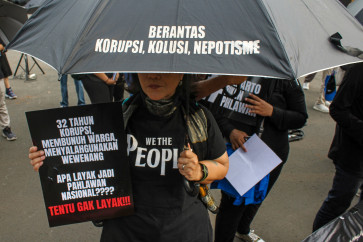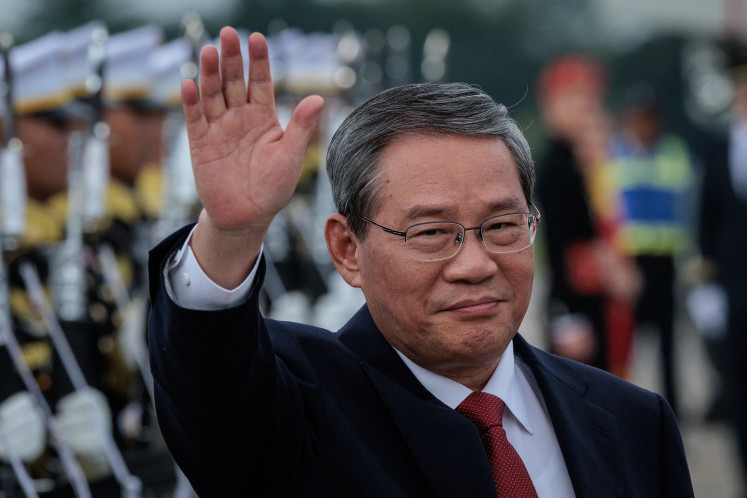Moon’s election may jolt coal exporters
Moon Jae-in’s recent election as president of South Korea not only heralds a new dawn for the country, but his pledges on energy policy may well have serious ramifications beyond its borders, not least for Indonesia’s coal exporters
Change text size
Gift Premium Articles
to Anyone

M
oon Jae-in’s recent election as president of South Korea not only heralds a new dawn for the country, but his pledges on energy policy may well have serious ramifications beyond its borders, not least for Indonesia’s coal exporters.
Faced with growing unrest from an urban population choking in high levels of air pollution, Moon has promised to re-assess the construction of new coal power plants, close older ones and dramatically ramp up the renewable energy target.
Effectively, his pledges would halve the long-term growth rate for thermal coal imports at a stroke.
This is important because South Korea is Asia’s fourth-largest economy and the fourth-largest importer of coal globally, accounting for over 10 percent of world thermal coal import demand.
The bulk of the market — around 40 percent — is made up of China and India, which are already well along the path to cutting coal imports to zero.
While China’s coal consumption surged earlier this month, hitting the peak level recorded in 2013, costs for solar in India hit another record low, dropping a remarkable 40 percent since the previous record which was made 16 months ago.
With solar power already cheaper than imported coal, India’s Energy Minister Piyush Goyal has repeatedly stated that his country will end coal imports by the end of the decade.
Indeed, Moon’s policies are in no way revolutionary. In fact, they are entirely consistent with the technology-driven energy market transformation that is taking place globally — and in Asia in particular.
For the coal industry, faced with this rapid shift, South Korea had long been identified as one of the remaining growth markets of significant size and a key source of ongoing viability.
Moon’s ascension may well snuff out this bright spot in the bleak overall outlook for seaborne coal used for electricity generation.
The implications for Indonesia, as the world’s largest exporter of coal, are impossible to miss. As Bloomberg analysts noted in an April update, “Indonesian miners may have the most to lose if thermal coal prices weaken in coming months” and “will bear the brunt” of the decline.
Notwithstanding the recently improved traded price of thermal coal, Indonesia’s major coal miners remain in financial distress and as such are extremely exposed to any sustained decrease in Asian imports.
Total Indonesian coal production for 2016 is estimated at 363 million tons, according to the Indonesian Coal Mining Association (APBI) and the Energy and Mineral Resources Ministry, 12.7 percent lower than 2015 production of 416 million tons.
Of this, the portion absorbed by the domestic coal market increased from about 21 percent in 2015 to 31 percent in 2016.
This still leaves about 70 percent of the coal vulnerable to changes in the export market.
Indika Energy finds itself particularly in the firing line with over 74 percent of its product destined for export.
Adaro Energy is not far behind at 70 percent. Being one of the top five thermal coal exporters in the world, Adaro sold 13 percent of its coal to South Korea in the first quarter of this year.
Granted, Indonesia’s primary markets are China and India, but any reduction in demand from the key North Asian markets will hurt pricing at a time when exporters are banking heavily on new growth.
Industry optimists may still point to improved demand from Vietnam, Malaysia, the Philippines and Thailand, which may climb slightly over the next few years. But this possible increase is dwarfed by the scale of the decline in China, India and now South Korea. Perhaps sensing the writing on the wall, even Vietnam is increasingly looking to realign to cheaper, domestic renewable energy opportunities.
Whilst the popular push for cleaner air is an important catalyst, governments all across Asia are seeking the opportunity to rejig their energy economies toward domestic renewable energy for the simple reason that it is increasingly cheaper. It should come as no surprise that South Korea is embracing the trend. Coal has long been an important earner for Indonesia, but the tide has turned.
The faster policymakers and companies face up to the stark reality of an export coal market in structural decline, the more they have to gain from the transition to renewable energy as it gathers pace.
______________________________
The writer is a Southeast Asia-based energy finance consultant at the Institute for Energy Economics and Financial Analysis.









